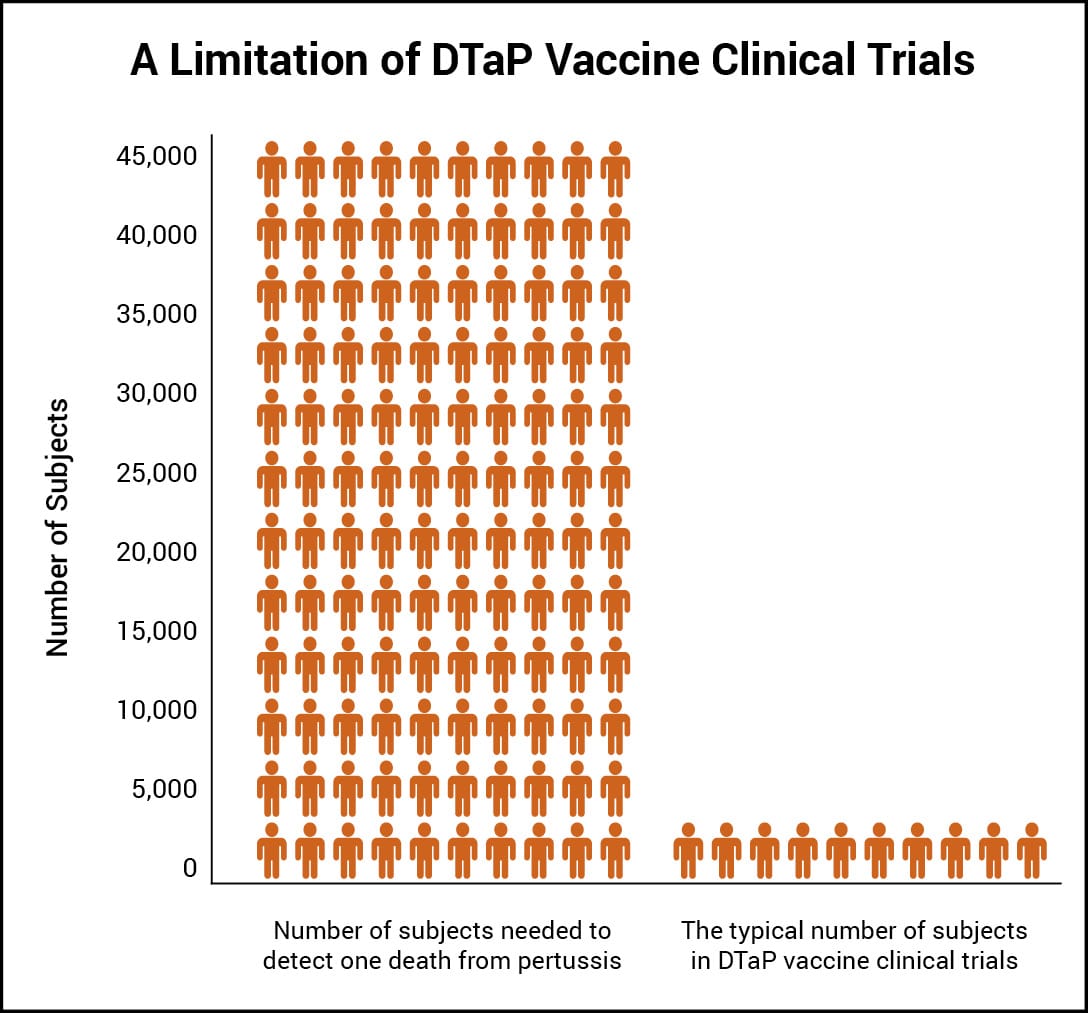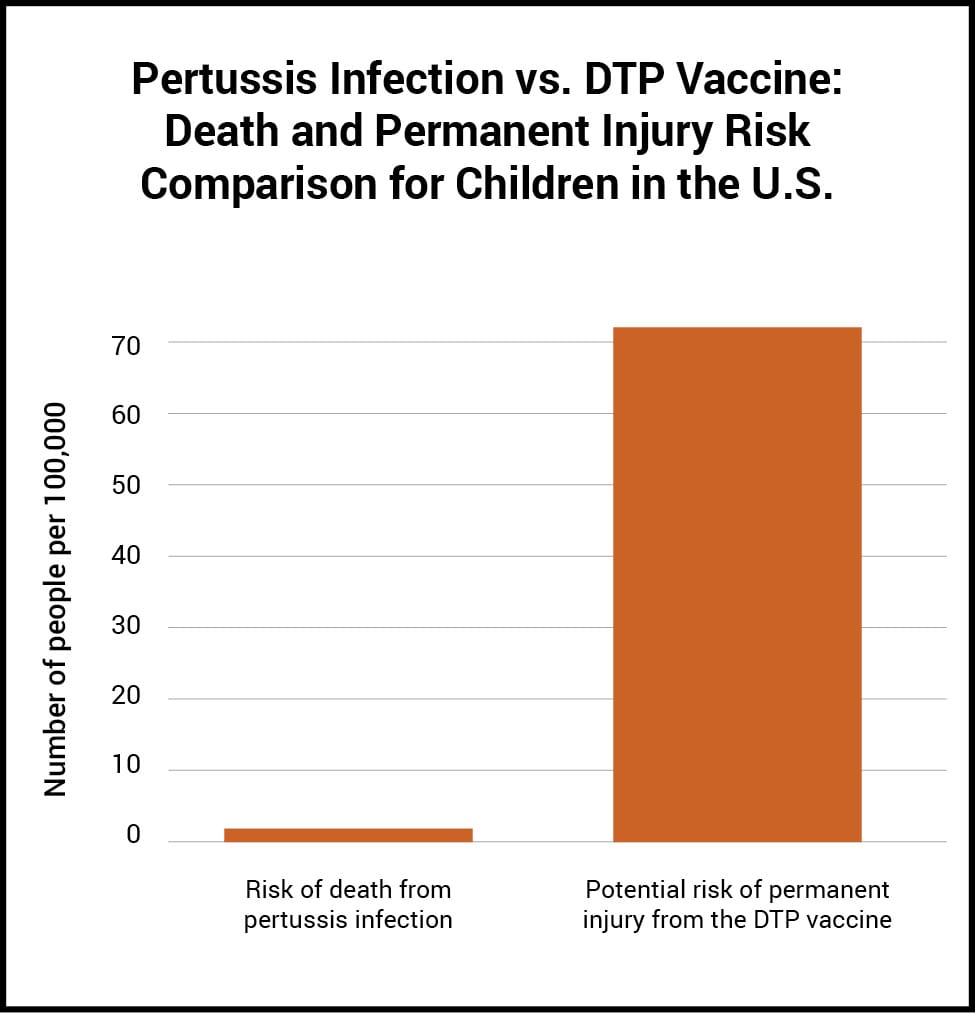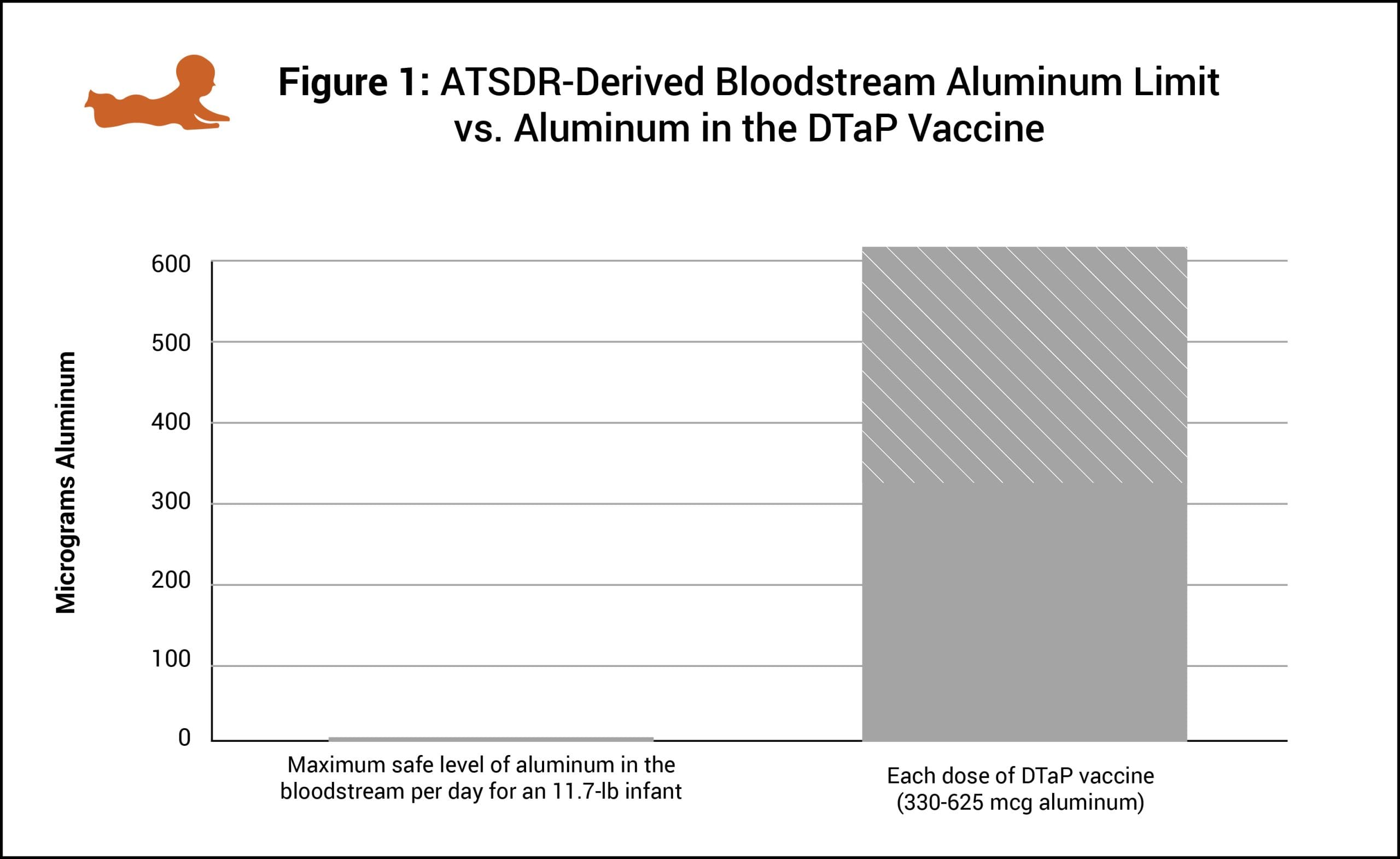DTaP Vaccine (Diphtheria, Tetanus, and Pertussis)
Is It Safer Than Pertussis (Whooping Cough)?
1. WHAT IS THE DTAP VACCINE?
DTaP is a descendant of the DTP vaccine, which was introduced in 1948. It has significantly reduced the incidence of reported (i.e., noticeable) cases of pertussis infections in children and adolescents; however, it does not prevent asymptomatic infection or the spread of pertussis.1
 2. WHAT ARE THE SIDE EFFECTS?
2. WHAT ARE THE SIDE EFFECTS?
Common side effects of the DTaP vaccine include fever, loss of appetite, vomiting, and fatigue/weakness.2 A more serious potential side effect is seizure, which may occur in about 1 in 683 children vaccinated with DTaP.3-6 Although severe side effects have been observed following DTaP vaccination, including neurological disorders (e.g., encephalitis, infantile spasms, ataxia, autism, transverse myelitis, optic neuritis, multiple sclerosis, Guillain-Barré syndrome, and Bell’s palsy), autoimmune diseases (e.g., chronic urticaria, serum sickness, and arthropathy), myocarditis, and sudden infant death syndrome, the Institute of Medicine (IOM) states that “the evidence is inadequate to accept or reject a causal relationship between diphtheria toxoid-, tetanus toxoid-, or acellular pertussis-containing vaccine” and those conditions.7 The DTaP vaccine contains 330 mcg to 625 mcg of aluminum,2,8 an amount 60 to 120 times greater than the maximum safe level of aluminum in the bloodstream per day for an 11.7-pound (5.3-kilogram) infant, derived from the Agency for Toxic Substances and Disease Registry, a division of the U.S. Department of Health and Human Services (HHS) (Fig. 1).9 Additionally, the manufacturer’s package insert states that the DTaP vaccine has “not been evaluated for carcinogenic or mutagenic potential or impairment of fertility.”2,8
 3. HOW ARE RISKS OF VACCINE SIDE EFFECTS MEASURED?
3. HOW ARE RISKS OF VACCINE SIDE EFFECTS MEASURED?
Methods to measure vaccine risks include surveillance systems, clinical trials, and epidemiological studies.
 4. HOW ACCURATE IS SURVEILLANCE OF ADVERSE EVENTS FROM THE DTAP VACCINE?
4. HOW ACCURATE IS SURVEILLANCE OF ADVERSE EVENTS FROM THE DTAP VACCINE?
The government tracks reported cases of vaccine side effects through the Vaccine Adverse Event Reporting System (VAERS). Approximately 130 cases of permanent injury and death from the DTaP vaccine are reported to VAERS annually.10 However, VAERS is a passive reporting system — authorities do not actively search for cases and do not actively remind doctors and the public to report cases. These limitations can lead to significant underreporting.11 The Centers for Disease Control and Prevention (CDC) states, “VAERS receives reports for only a small fraction of actual adverse events.”12 Indeed, as few as 1% of serious side effects from medical products are reported to passive surveillance systems.13 In addition, VAERS reports are not proof that a side effect occurred, as the system is not designed to thoroughly investigate all cases.14 As a result, VAERS does not provide an accurate count of DTaP vaccine side effects.
 5. HOW ACCURATE ARE CLINICAL TRIALS OF THE DTAP VACCINE?
5. HOW ACCURATE ARE CLINICAL TRIALS OF THE DTAP VACCINE?
The CDC states, “Prelicensure trials are relatively small — usually limited to a few thousand subjects — and usually last no longer than a few years… Prelicensure trials usually do not have the ability to detect rare adverse events or adverse events with delayed onset.”11 Because the risk of an infant younger than age 1 contracting a fatal case of pertussis in the U.S. is about 1 in 46,000 in the absence of mass vaccination,15 a few thousand subjects in clinical trials are not enough to prove that the DTaP vaccine causes less permanent injury or death than pertussis (Fig. 2).

Figure 2: There are not enough subjects in clinical trials to prove that the DTaP vaccine poses less risk than pertussis.
6. HOW ACCURATE ARE EPIDEMIOLOGICAL STUDIES OF THE DTAP VACCINE?
Epidemiological studies are hindered by the effects of chance. The largest epidemiological studies of pertussis-containing vaccines observed DTP, the predecessor of the DTaP vaccine. For example, a study published in the Journal of the American Medical Association (JAMA) involving about 467,000 children compared two DTP vaccines to determine if one vaccine caused more permanent injury than the other. Although the study found no statistically significant difference between the two vaccines, it did not rule out the possibility that one of the vaccines increased the risk of adverse events resulting in permanent injury by up to 43%.16 Consequently, the study did not rule out the possibility that such adverse events might occur up to 33 times more often than fatal pertussis in infants: 1 in 1,400 compared to 1 in 46,000 (Fig. 3 and Table 1). The range of possibilities found in the study makes the result inconclusive; even large epidemiological studies are not accurate enough to prove that the DTaP vaccine causes less permanent injury or death than pertussis in infants.
![]()
7. IS THE DTAP VACCINE SAFER THAN PERTUSSIS?
It has not been proven that the DTaP vaccine is safer than pertussis. The vaccine package insert raises questions about safety testing for cancer, genetic mutations, and impaired fertility. Although VAERS tracks some adverse events, it is too inaccurate to measure against the risk of pertussis. Clinical trials do not have the ability to detect less common adverse reactions, and epidemiological studies are limited by the effects of chance. Safety studies of DTaP vaccines are lacking in statistical power. A review of DTaP vaccine safety studies conducted by the IOM found that the evidence was inadequate to rule out the possibility that DTaP vaccination leads to more than two dozen neurological and autoimmune disorders.7 Because permanent sequelae (aftereffects) from pertussis are so rare, the level of accuracy of the research studies available is insufficient to prove that the DTaP vaccine causes less permanent injury or death than pertussis.
 8. WHAT ABOUT THE TDAP VACCINE?
8. WHAT ABOUT THE TDAP VACCINE?
Tdap is a different formulation of DTaP that is approved for use in adults and older children, as DTaP is only approved for infants and young children.17 Surveillance systems, clinical trials, and epidemiological studies of Tdap have similar limitations as those of DTaP.

Figure 3: A study published in JAMA did not rule out the possibility that a DTP vaccine can cause an adverse event leading to permanent injury 33 times more often than pertussis can be fatal for U.S. infants.

REFERENCES
- Physicians for Informed Consent. Newport Beach (CA): Physicians for Informed Consent. Pertussis — disease information statement (DIS). Pertussis (whooping cough): what parents need to know. 2023 Apr. https://physiciansforinformedconsent.org/pertussis-dis.
- Sanofi Pasteur Limited. Toronto, Ontario, Canada: Sanofi. Daptacel (diphtheria and tetanus toxoids and acellular pertussis vaccine adsorbed); [cited 2023 Jan 2]. https://www.fda.gov/media/74035/download.
- Between 2000 and 2004, the Vaccine Adverse Event Reporting System (VAERS) received 579 reports of seizure-related adverse events involving DTaP in children <1 year of age.4 In the same time period, VAERS received 618 reports of seizure-related adverse events involving measles vaccine in children 1-2 years of age.5 This suggests that seizures from DTaP vaccine may occur 94% as often as seizures from MMR vaccine, 94% of 1 in 6406 or about 1 in 683.
- Centers for Disease Control and Prevention. Washington, D.C.: U.S. Department of Health and Human Services. CDC wonder: about the Vaccine Adverse Event Reporting System (VAERS); [cited 2022 October 10]. https://wonder.cdc.gov/vaers.html. Query for seizure-related events involving DTaP vaccine, 2000-2004.
- Centers for Disease Control and Prevention. Washington, D.C.: U.S. Department of Health and Human Services. CDC wonder: about the Vaccine Adverse Event Reporting System (VAERS); [cited 2022 October 20]. https://wonder.cdc.gov/vaers.html. Query for seizure-related events involving all measles-containing vaccines, 2000-2004.
- Vestergaard M, Hviid A, Madsen KM, Wohlfahrt J, Thorsen P, Schendel D, Melbye M, Olsen J. MMR vaccination and febrile seizures: evaluation of susceptible subgroups and long-term prognosis. JAMA. 2004 Jul 21;292(3):356. https://jamanetwork.com/journals/jama/fullarticle/199117.
- Institute of Medicine (IOM). Adverse effects of vaccines: evidence and causality. Washington, D.C.: National Academies Press; 2012. 525-84. https://www.ncbi.nlm.nih.gov/books/NBK190024/pdf/Bookshelf_NBK190024.pdf.
- GlaxoSmithKline Biologics. Rixensart, Belgium: GlaxoSmithKline. Infanrix (diphtheria and tetanus toxoids and acellular pertussis vaccine adsorbed); [cited 2023 Feb 23]. http://wayback.archive-it.org/7993/20170723024611/https://www.fda.gov/downloads/BiologicsBloodVaccines/Vaccines/ApprovedProducts/UCM124514.pdf; as of November 2022, the FDA posted an updated package insert, with decreased aluminum content, to its Infanrix product information webpage. No documentation is available explaining the change in the aluminum content. PIC has filed a FOIA request to examine the discrepancy.
- Physicians for Informed Consent. Newport Beach (CA): Physicians for Informed Consent. Aluminum – vaccine risk statement (VRS). Aluminum in vaccines: what parents need to know; 2020 Aug; updated 2023 Apr [cited 2023 Apr 16]. https://physiciansforinformedconsent.org/aluminum-in-vaccines.
- Centers for Disease Control and Prevention. Washington, D.C.: U.S. Department of Health and Human Services. CDC wonder: about the Vaccine Adverse Event Reporting System (VAERS); [cited 2022 December 1]. https://wonder.cdc.gov/vaers.html. Query for death and permanent disability involving DTaP vaccine, 2000-2004.
- Centers for Disease Control and Prevention. Manual for the surveillance of vaccine-preventable diseases. 5th ed. Miller ER, Haber P, Hibbs B, Broder K. Chapter 21: surveillance for adverse events following immunization using the Vaccine Adverse Event Reporting System (VAERS). Atlanta: Centers for Disease Control and Prevention; 2011. 1,2,8. https://physiciansforinformedconsent.org/cdc-manual-for-the-surveillance-of-vaccine-preventable-diseases-5th-ed-chpt21-surv-adverse-events-2011.
- Centers for Disease Control and Prevention, Food and Drug Administration. Washington D.C.: U.S. Department of Health and Human Services. Guide to interpreting VAERS data; [cited 2022 May 28]. https://vaers.hhs.gov/data/dataguide.html.
- Kessler DA. Introducing MEDWatch. A new approach to reporting medication and device adverse effects and product problems. JAMA. 1993 Jun 2;269(21):2765-8. https://www.sciencedirect.com/science/article/abs/pii/0163834394900515?via%3Dihub.
- Centers for Disease Control and Prevention. Washington D.C.: U.S. Department of Health and Human Services. CDC wonder: about the Vaccine Adverse Event Reporting System (VAERS); [cited 2022 May 28]. https://wonder.cdc.gov/vaers.html.
- Magno H, Golomb B. Measuring the benefits of mass vaccination programs in the United States. Vaccines. 2020 Sep 29;8(4):561. https://pubmed.ncbi.nlm.nih.gov/33003480/; 71% (87) of the 123 pertussis deaths reported in the study were infants less than 1 year of age. Because there are about 4 million such infants in the population, the risk of fatal pertussis for those infants is 87 in 4 million (1 in 46,000).
- Hviid A, Stellfeld M, Wohlfahrt J, Melbye M. Association between thimerosal-containing vaccine and autism. JAMA. 2003 Oct 1;290(13):1763-6. https://pubmed.ncbi.nlm.nih.gov/14519711/.
- Centers for Disease Control and Prevention, National Center for Emerging and Zoonotic Infectious Diseases (NCEZID), Division of Healthcare Quality Promotion (DHQP). Washington D.C.: U.S. Department of Health and Human Services. Diphtheria, tetanus, and pertussis vaccines; [cited 2023 Feb 15]. https://www.cdc.gov/vaccinesafety/vaccines/dtap-tdap-vaccine.html.
These statements are intended for informational purposes only and should not be construed as personal medical advice.
© 2023 Physicians for Informed Consent, an independent 501(c)(3) nonprofit educational organization.
All rights reserved. 2023 Apr.



